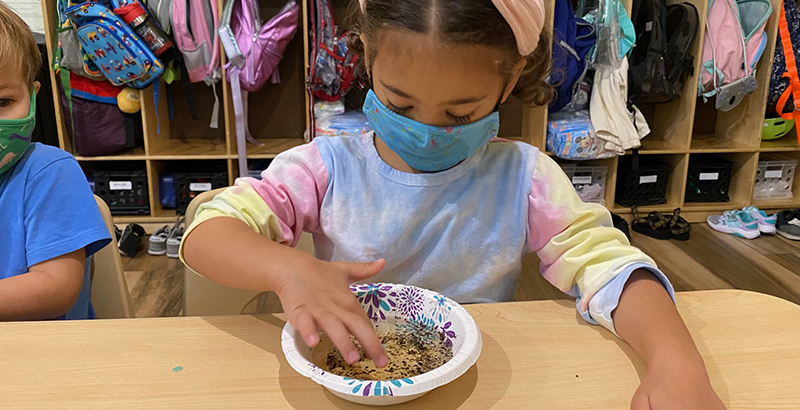An Educator’s View: Preschoolers As Young as 2 Can Learn About Science — and Love It. Here’s How

Get stories like this delivered straight to your inbox. Sign up for The 74 Newsletter
Kids are natural scientists. Every parent remembers that phase when their children constantly asked “Why?” As kids get older, they might get more afraid of asking questions or getting things wrong. Preschoolers, though, haven’t learned to be embarrassed yet, and at Brooklyn Preschool of Science, my teachers want them to get things wrong. They want kids to explore the world around them, to keep asking “Why?” and trying to answer their own question.
Encouraging students to act like scientists frees them to playfully engage this side of themselves and makes them happy come to school. Here are a few ways educators can incorporate this inquiry-based approach into their early learning classrooms.
Kids love to learn about the animals that live around them. To teach the theme of Animals in the Community, we use wonderful critters called mealworms, which metamorphose into darkling beetles. The science concepts include the life cycle of an insect, to the parts of an insect and habitats. Through the lens of this mealworm, the students are introduced to different subject matter and develop skills without even knowing it.
They use tongs and magnifiers to observe and handle the creatures, which develops their fine motor skills. They incorporate math by measuring the length of the mealworm using Unifix interlocking plastic counting cubes. They create Jackson Pollack-style art by dropping hundreds of mealworms onto craft paper that is coated with paint, and watch as the worms walk across the paint and make fantastic designs.
As they learn about the parts of the darkling beetle— the head, thorax, and abdomen — the kids draw what they’d like their own bug to look like. Using the software that comes with a simple 3D printers, teachers convert those drawings to 3D images that they then print. Not only does this connect art and technology, but it gives kids something they can hold in their hand and take home to show their parents.
Another tech tool that appeals to preschoolers is a robot called Kibo. It incorporates robotics and computational learning, but instead of coding by cutting and pasting virtually, on a screen, kids move actual wooden blocks, each of which has a command printed on it. They then use the robot to scan the blocks and set their program in motion. So they’re learning fundamental coding concepts like sequencing, but they’re also playing with blocks.
The best way to help preschoolers learn and retain the basics of the scientific method is to make it fun. One of my teachers starts each project with a sing-songy call-and-response. She says, “First you ask a question,” and then the kids repeat that phrase back as a class. She does the same thing with “Then we make a prediction,” “Then we test it” and “And get our results!”
Notice that it’s not “right results” or “wrong results.” The goal is for the kids to enjoy the process and get results. If they don’t get the expected outcome, the class tries to figure out why. For example, if the kids are sprouting pumpkins seeds in a wet paper towel and one child adds too much water, the seed won’t sprout — and that’s a learning experience. By touching the seeds that sprouted and the one that didn’t, they’ll be able to decipher the “why” — that one has more water than the others.
With early learners, how you teach matters almost as much as what you teach. Preschoolers won’t sit through long explanations; they want to touch and hold things. For example, in our lesson about birds and feathers, the teacher demonstrates how to use an eyedropper to determine how many droplets the feather can absorb. The children can’t wait to get a hold of the dropper. As soon as they see what to do, droplets start falling and kids start counting.
This sort of hands-on learning makes science a universal language. Even in schools where children may not speak English at home, the language barrier vanishes when teachers do visual demonstrations and then literally put learning in students’ hands.
Perhaps the most important universal language preschool teachers should use is humor. If you ask preschoolers a question in a way that makes them laugh, they’re going to be more open to learning. If you can connect all these subjects with a playful yet scientific approach, you’ll inspire kids to joyfully explore their world.
Carmelo Piazza is the executive director/educational director of Brooklyn Preschool of Science. He can be reached at carmelo@brooklynpreschoolofscience.com.
Get stories like these delivered straight to your inbox. Sign up for The 74 Newsletter

;)